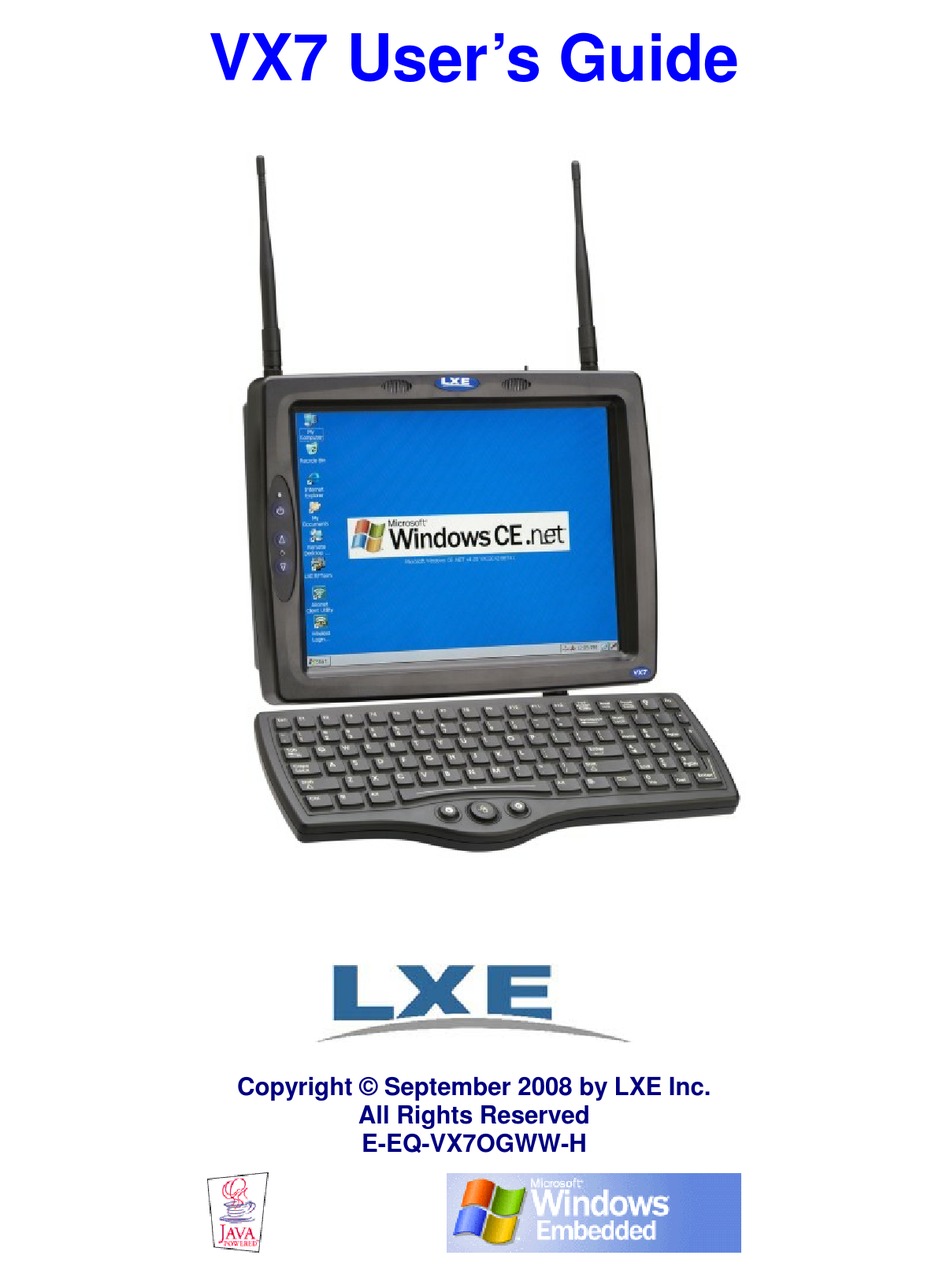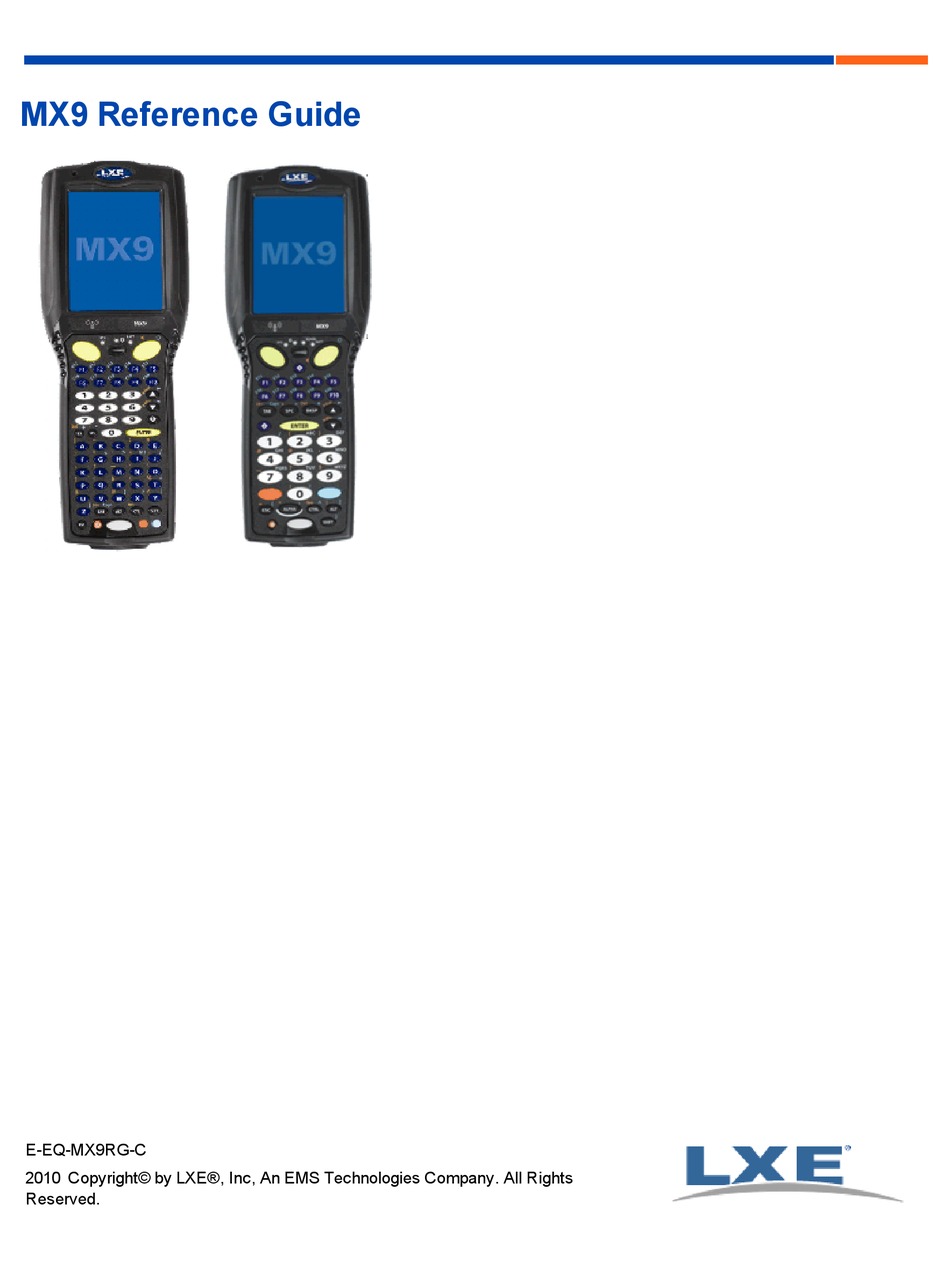Manuals and User Guides for LXE HX2. We have 4 LXE HX2 manuals available for free PDF download: Reference Manual. Install Activesync On Desktop/Laptop. The LXE Marathon, introduced in November of 2010, bridges the gaps between PDAs, notebooks and tablets. It's a cross-over product somewhere between LXE's PDA-style handhelds and their vehicle-mount computers, and it also crosses the functionalities usually provided by either a Windows CE/Windows Mobile device, and one that runs full Windows.
 LXE Marathon Field Computer
LXE Marathon Field ComputerLXE uses open-book form factor for its new Windows-based rugged field computer
(by Conrad H. Blickenstorfer)

The LXE Marathon, introduced in November of 2010, bridges the gaps between PDAs, notebooks and tablets. It's a cross-over product somewhere between LXE's PDA-style handhelds and their vehicle-mount computers, and it also crosses the functionalities usually provided by either a Windows CE/Windows Mobile device, and one that runs full Windows. So what exactly is the LXE Marathon?
It is a tablet computer that also has a QWERTY keyboard. That's a lot of functionality to pack onto the surface of a ruggedized device with a footprint of just 8.1 x 7.8 inches. But LXE managed to do it while still providing a reasonably large display (7 inches diagonal) with acceptably high and nicely matched resolution (800 x 480 pixel), and a full keyboard that even includes a separate keypad.
Unlike some full keyboards we've seen on similar designs, LXE gave the Marathon a small 58%-scale version of a standard keyboard, and not one of those (often gimmicky) layouts that assumes users will thumbtype like on a giant Blackberry. This way, users will feel right at home on the Marathon's keyboard, small though it is, and it seems a good solution. There are also ten assignable function keys, and those always come in handy on tablet computers.


Under the hood, the Marathon employs the Intel Atom ciruitry that's been powering an increasing number of lightweight, fanless tablets, panels and similar devices that require adequate computing power while generating little heat and going easy on the battery. LXE chose the by now almost ubiquitous 1.6GHz Atom Z530, one of the first Atom processors released. The Z530 enjoys 'embedded' status, which means that Intel will support it for many years. Even combined with its US15W companion chip, this frugal chipset uses just about 5 watts.
On the ruggedness side, the Marathon specs indicate IP65 sealing, where the '6' means the device is totally dust-proof and the '5' that it can handle low-pressure water jets from all directions; the ability to survive multiple 4-foot drops to concrete; and it has a wide operating temperature range of 4 to 122 degrees Fahrenheit. LXE also lists additional ruggedness testing as well as numerous certifications (see specs).
The Marathon has adequate onboard connectivity (USB, audio), with much more available via external docks (desktop and vehicle cradles are available). There's 802.11a/b/g/n WiFi and Bluetooth 2.1. AGPS is included, and there are internal antennas. The Marathon can be customized for various data collection tasks via an optional 2D imager, 2-megapixel AF camera (top-center on backside), and magnetic stripe reader.
While the Marathon concept is innovative and has plenty of application potential, there are some caveats. Despite the low-power Atom processor, the small standard battery is only good for 2.5 hours or so. That's enough if the unit is only occasionally removed from a dock, but not in the field. For that, LXE provides secondary 6 and 9-hour batteries that snap onto the back of the Marathon, extending thickness some. Outdoor users will want the optional transflective display as the standard transmissive display, while bright (400 nits), is primarily for warehousing and other indoor applications. The Marathon's resistive touch screen probably works well for custom apps, but Windows itself has never been a good match for resistive touch.
Overall, the Marathon is a very good addition to LXE's lineup. Microsoft hasn't really done much with Windows CE for the past few years, and many applications now require full Windows 7 or XP. Though not a speed demon, the Atom Z530 has proven to be able to run full Windows implementations, and especially those based on embedded versions. LXE also is one of the few who offers such a 'cross-over' device (others are primarily the Panasonic U1, the DAP M8920, the DLI 8400, the Arbor Gladius 720, and the Black Diamond SwitchBack), and the LXE Marathon certainly adds a very attractive contender.
Below is a video describing the Marathon that LXE, which became part of Honeywell in 2011, released in September of 2011.
LXE Marathon Field Computer
LXE uses open-book form factor for its new Windows-based rugged field computer
(by Conrad H. Blickenstorfer)
The LXE Marathon, introduced in November of 2010, bridges the gaps between PDAs, notebooks and tablets. It's a cross-over product somewhere between LXE's PDA-style handhelds and their vehicle-mount computers, and it also crosses the functionalities usually provided by either a Windows CE/Windows Mobile device, and one that runs full Windows. So what exactly is the LXE Marathon?
It is a tablet computer that also has a QWERTY keyboard. That's a lot of functionality to pack onto the surface of a ruggedized device with a footprint of just 8.1 x 7.8 inches. But LXE managed to do it while still providing a reasonably large display (7 inches diagonal) with acceptably high and nicely matched resolution (800 x 480 pixel), and a full keyboard that even includes a separate keypad.
Unlike some full keyboards we've seen on similar designs, LXE gave the Marathon a small 58%-scale version of a standard keyboard, and not one of those (often gimmicky) layouts that assumes users will thumbtype like on a giant Blackberry. This way, users will feel right at home on the Marathon's keyboard, small though it is, and it seems a good solution. There are also ten assignable function keys, and those always come in handy on tablet computers.
Under the hood, the Marathon employs the Intel Atom ciruitry that's been powering an increasing number of lightweight, fanless tablets, panels and similar devices that require adequate computing power while generating little heat and going easy on the battery. LXE chose the by now almost ubiquitous 1.6GHz Atom Z530, one of the first Atom processors released. The Z530 enjoys 'embedded' status, which means that Intel will support it for many years. Even combined with its US15W companion chip, this frugal chipset uses just about 5 watts.
On the ruggedness side, the Marathon specs indicate IP65 sealing, where the '6' means the device is totally dust-proof and the '5' that it can handle low-pressure water jets from all directions; the ability to survive multiple 4-foot drops to concrete; and it has a wide operating temperature range of 4 to 122 degrees Fahrenheit. LXE also lists additional ruggedness testing as well as numerous certifications (see specs).
Lxe Laptops & Desktops Driver Downloads
The Marathon has adequate onboard connectivity (USB, audio), with much more available via external docks (desktop and vehicle cradles are available). There's 802.11a/b/g/n WiFi and Bluetooth 2.1. AGPS is included, and there are internal antennas. The Marathon can be customized for various data collection tasks via an optional 2D imager, 2-megapixel AF camera (top-center on backside), and magnetic stripe reader.
While the Marathon concept is innovative and has plenty of application potential, there are some caveats. Despite the low-power Atom processor, the small standard battery is only good for 2.5 hours or so. That's enough if the unit is only occasionally removed from a dock, but not in the field. For that, LXE provides secondary 6 and 9-hour batteries that snap onto the back of the Marathon, extending thickness some. Outdoor users will want the optional transflective display as the standard transmissive display, while bright (400 nits), is primarily for warehousing and other indoor applications. The Marathon's resistive touch screen probably works well for custom apps, but Windows itself has never been a good match for resistive touch.
LXE Laptops & Desktops Driver Download
Overall, the Marathon is a very good addition to LXE's lineup. Microsoft hasn't really done much with Windows CE for the past few years, and many applications now require full Windows 7 or XP. Though not a speed demon, the Atom Z530 has proven to be able to run full Windows implementations, and especially those based on embedded versions. LXE also is one of the few who offers such a 'cross-over' device (others are primarily the Panasonic U1, the DAP M8920, the DLI 8400, the Arbor Gladius 720, and the Black Diamond SwitchBack), and the LXE Marathon certainly adds a very attractive contender.
Below is a video describing the Marathon that LXE, which became part of Honeywell in 2011, released in September of 2011.
